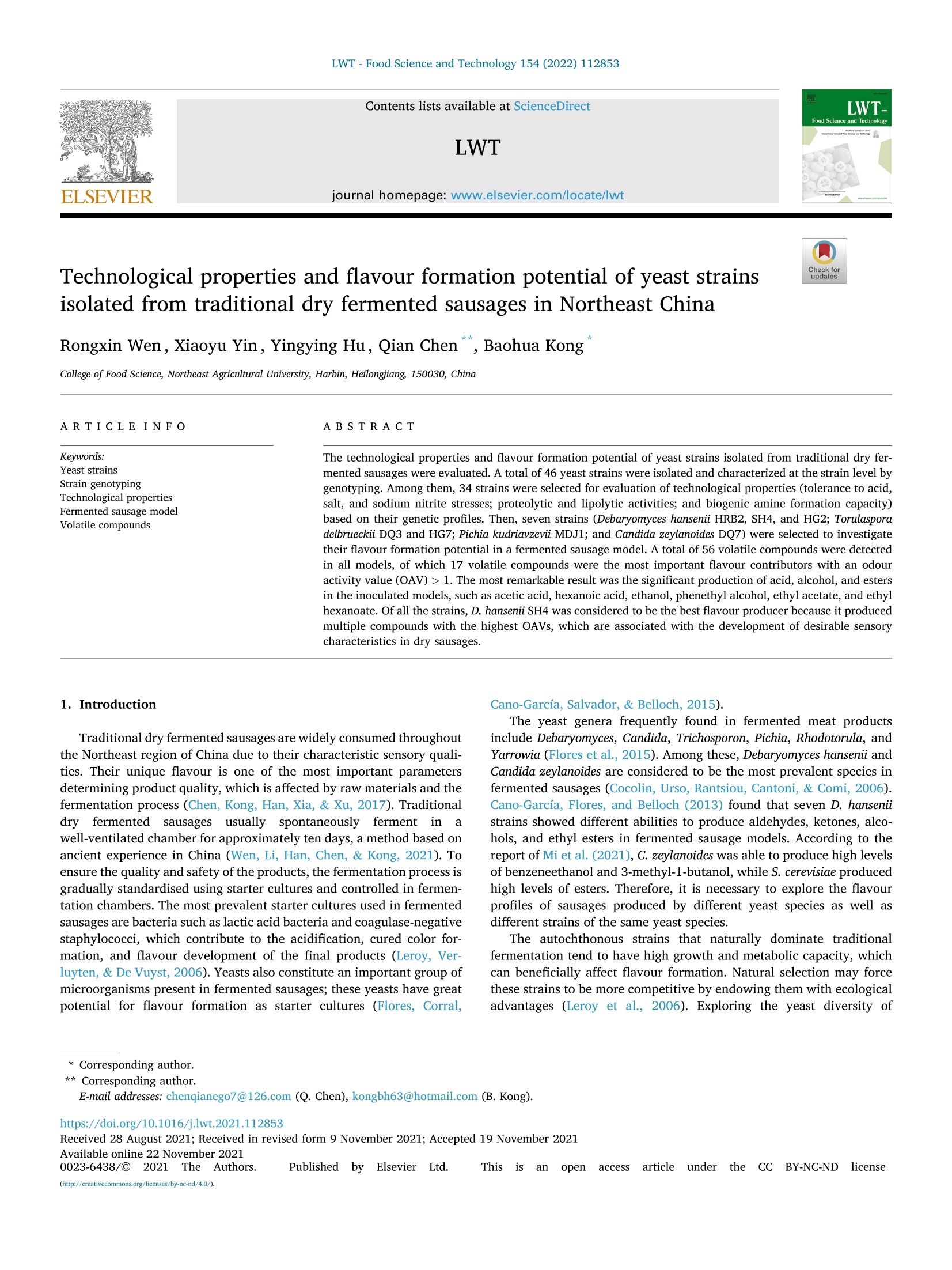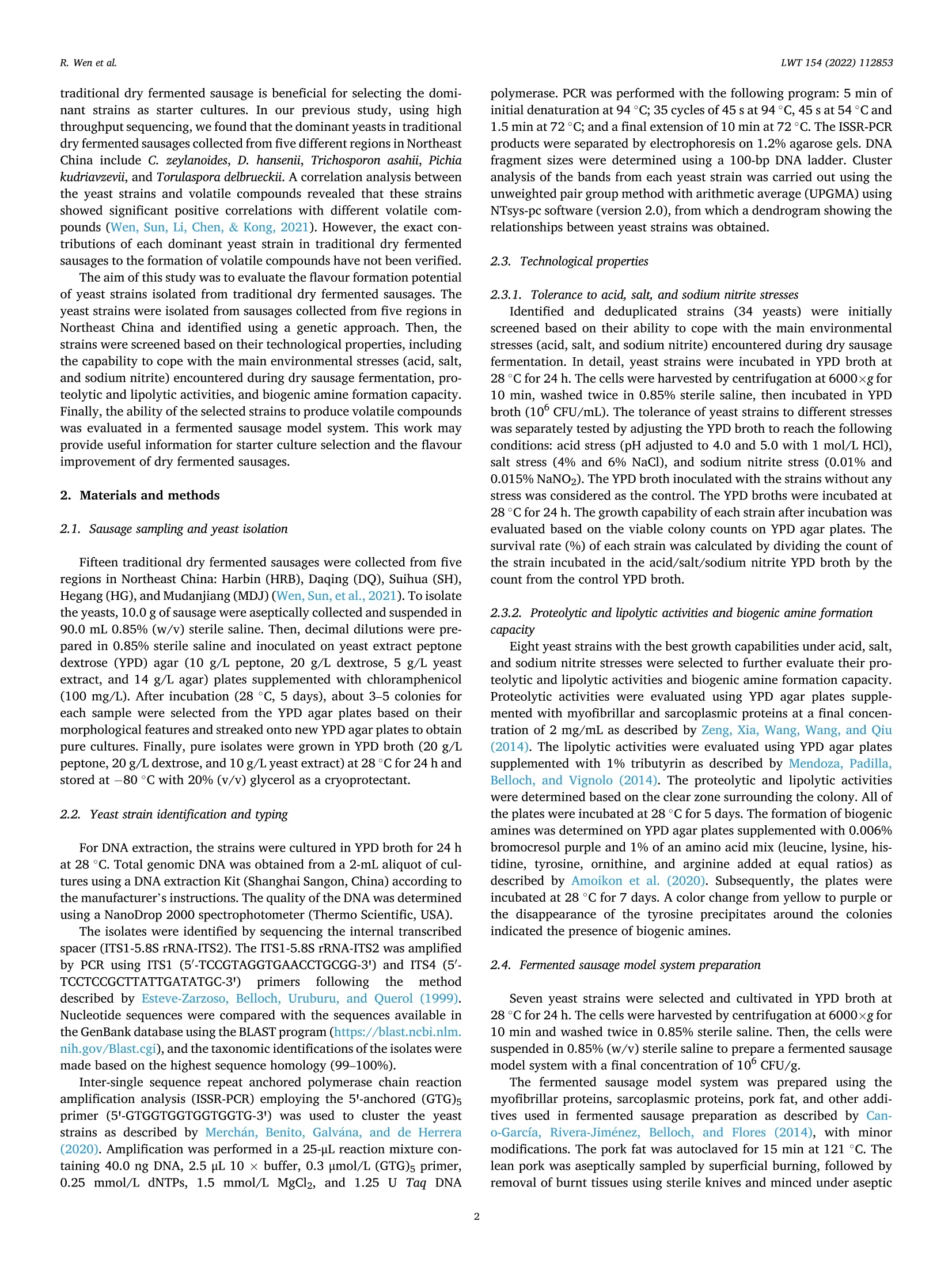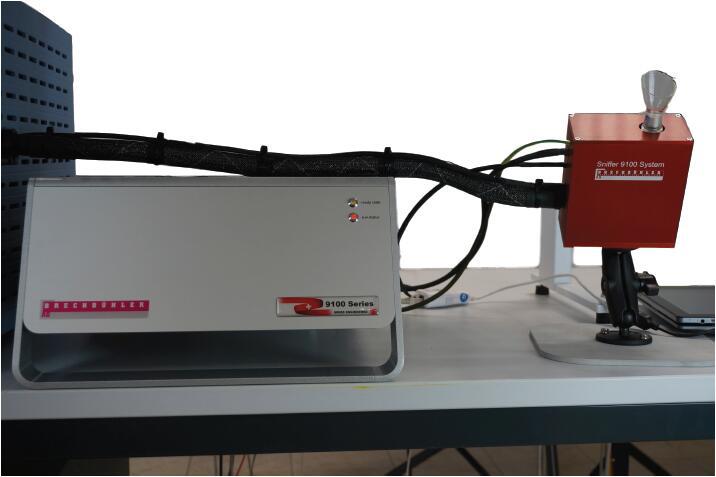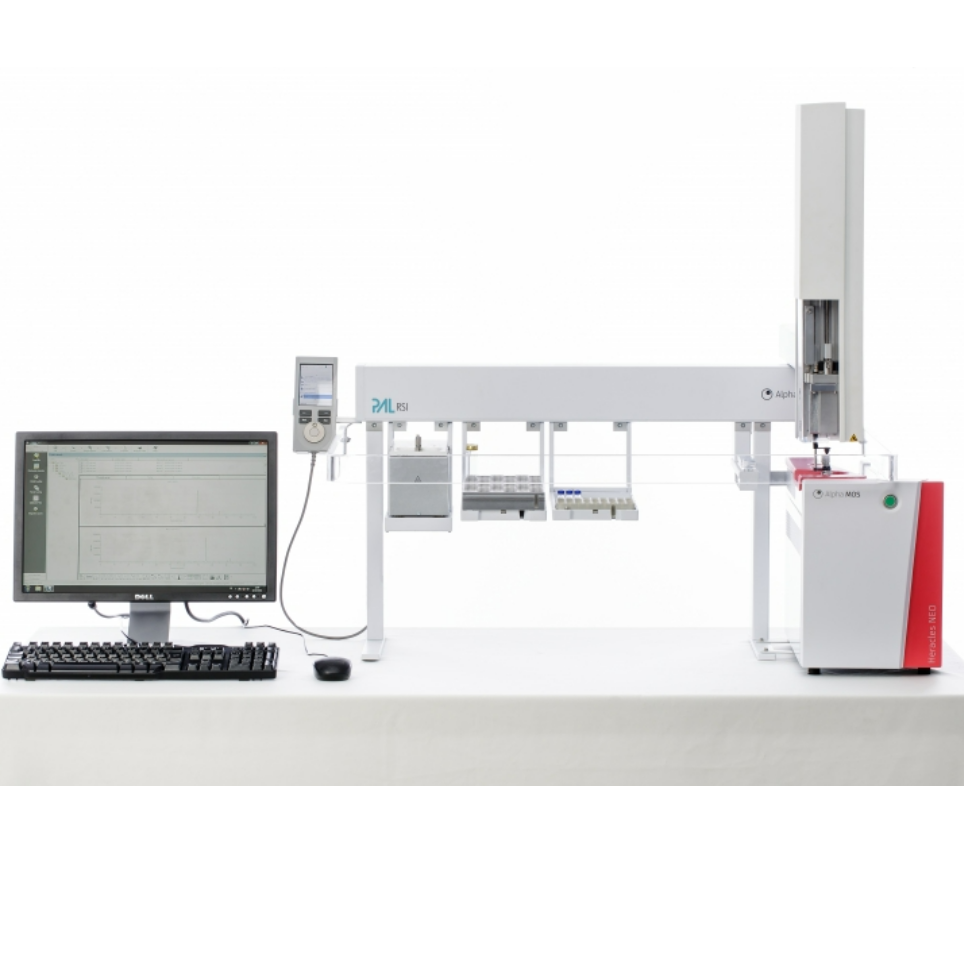方案详情文
智能文字提取功能测试中
LWT-Food Science and Technology 154 (2022)112853journal homepage: www.elsevier.com/locate/lwt R. Wen et al.LWT 154 (2022)112853 Contents lists available at ScienceDirect LWT Technological properties and flavour formation potential of yeast strainsisolated from traditional dry fermented sausages in Northeast China Rongxin Wen, Xiaoyu Yin, Yingying Hu, Qian Chen,. Baohua KongCollege of Food Science, Northeast Agricultural University, Harbin, Heilongjiang, 150030, China ARTICLEIN F O ABSTRA C T Keywords:Yeast strainsStrain genotypingTechnological propertiesFermented sausage modelVolatile compounds The technological properties and flavour formation potential of yeast strains isolated from traditional dry fer-mented sausages were evaluated. A total of 46 yeast strains were isolated and characterized at the strain level bygenotyping. Among them, 34 strains were selected for evaluation of technological properties (tolerance to acid,salt, and sodium nitrite stresses; proteolytic and lipolytic activities; and biogenic amine formation capacity)based on their genetic profiles. Then, seven strains (Debaryomyces hansenii HRB2, SH4, and HG2; Torulasporadelbrueckii DQ3 and HG7; Pichia kudriavzevii MDJ1; and Candida zeylanoides DQ7) were selected to investigatetheir flavour formation potential in a fermented sausage model. A total of 56 volatile compounds were detectedin all models, of which 17 volatile compounds were the most important flavour contributors with an odouractivity value (OAV)> 1. The most remarkable result was the significant production of acid, alcohol, and estersin the inoculated models, such as acetic acid, hexanoic acid, ethanol, phenethyl alcohol, ethyl acetate, and ethylhexanoate. Of all the strains, D. hansenii SH4 was considered to be the best flavour producer because it producedmultiple compounds with the highest OAVs, which are associated with the development of desirable sensorycharacteristics in dry sausages. 1. Introduction Traditional dry fermented sausages are widely consumed throughoutthe Northeast region of China due to their characteristic sensory quali-ties. Their unique flavour is one of the most important parametersdetermining product quality, which is affected by raw materials and thefermentation process (Chen, Kong, Han, Xia, & Xu, 2017). Traditionaldryfermented sausages usually spontaneously fermenttin awell-ventilated chamber for approximately ten days, a method based onancient experience in China (Wen, Li, Han, Chen, & Kong, 2021). Toensure the quality and safety of the products, the fermentation process isgradually standardised using starter cultures and controlled in fermen-tation chambers. The most prevalent starter cultures used in fermentedsausages are bacteria such as lactic acid bacteria and coagulase-negativestaphylococci, which contribute to the acidification, cured color for-mation, and flavour development of the final products (Leroy, Ver-luyten, & De Vuyst, 2006). Yeasts also constitute an important group ofmicroorganisms present in fermented sausages; these yeasts have greatpotential for flavour formation as starter cultures (Flores, Corral, The autochthonous strains that naturally dominate traditionalfermentation tend to have high growth and metabolic capacity, whichcan beneficially affect flavour formation. Natural selection may forcethese strains to be more competitive by endowing them with ecologicaladvantages (Leroy et al.,,22006). Exploring the yeast diversity of ( * Corresponding author. ) ** Corresponding author. ( E-mail addresses : chen q ianego7 @ 1 26.c o m ( Q. Chen), k ongb h6 3@hotma i l.c o m (B. Kong). ) ( https: // doi.org / 10 . 1016/j . lwt.202 1 . 112853 ) ( Received 2 8 August 2021; Received in revise d form 9 November 2021; Accepted 19 November 2 021 ) ( Available online 22 November 2021 ) ( 0023-6438/C ) 2021 Th : e Authors. Published by E Elsevierr L td. This is an open access article underp rt he CCBY-NC-ND license ( h t t p :/ / c r e a ti vec om mons. o rg /li cens es /b y - n c - nd / 4 . 0 / ) . ) traditional dry fermented sausage is beneficial for selecting the domi-nant strains as starter cultures. In our previous study, using highthroughput sequencing, we found that the dominant yeasts in traditionaldry fermented sausages collected from five different regions in NortheastChina include C. zeylanoides, D. hansenii, Trichosporon asahii, Pichiakudriavzevii, and Torulaspora delbrueckii. A correlation analysis betweenthe yeast strains and volatile compounds revealed that these strainsshowed significant positive correlations with different volatile com-pounds (Wen, Sun, Li, Chen, & Kong, 2021). However, the exact con-tributions of each dominant yeast strain in traditional dry fermentedsausages to the formation of volatile compounds have not been verified. The aim of this study was to evaluate the flavour formation potentialof yeast strains isolated from traditional dry fermented sausages. Theyeast strains were isolated from sausages collected from five regions inNortheast China and identified using a genetic approach. Then, thestrains were screened based on their technological properties, includingthe capability to cope with the main environmental stresses (acid, salt,and sodium nitrite) encountered during dry sausage fermentation, pro-teolytic and lipolytic activities, and biogenic amine formation capacity.Finally, the ability of the selected strains to produce volatile compoundswas evaluated in a fermented sausage model system. This work mayprovide useful information for starter culture selection and the flavourimprovement of dry fermented sausages. 2. Materials and methods 2.1. Sausage sampling and yeast isolation Fifteen traditional dry fermented sausages were collected from fiveregions in Northeast China: Harbin (HRB), Daqing (DQ), Suihua (SH),Hegang (HG), and Mudanjiang (MDJ) (Wen, Sun, et al., 2021). To isolatethe yeasts, 10.0 g of sausage were aseptically collected and suspended in90.0 mL 0.85%(w/v) sterile saline. Then, decimal dilutions were pre-pared in 0.85% sterile saline and inoculated on yeast extract peptonedextrose (YPD) agar (10 g/L peptone, 20 g/L dextrose, 5 g/L yeastextract, and 14 g/L agar) plates supplemented with chloramphenicol(100 mg/L). After incubation (28°C, 5 days), about 3-5 colonies foreach sample were selected from the YPD agar plates based on theirmorphological features and streaked onto new YPD agar plates to obtainpure cultures. Finally, pure isolates were grown in YPD broth (20 g/Lpeptone, 20 g/L dextrose, and 10 g/L yeast extract) at 28°C for 24 h andstored at -80 °C with 20% (v/v) glycerol as a cryoprotectant. 2.2. Yeast strain identification and typing For DNA extraction, the strains were cultured in YPD broth for 24 hat 28 °C. Total genomic DNA was obtained from a 2-mL aliquot of cul-tures using a DNA extraction Kit (Shanghai Sangon, China) according tothe manufacturer’s instructions. The quality of the DNA was determinedusing a NanoDrop 2000 spectrophotometer (Thermo Scientific, USA). The isolates were identified by sequencing the internal transcribedspacer (ITS1-5.8S rRNA-ITS2). The ITS1-5.8S rRNA-ITS2 was amplifiedby PCR using ITS1 (5-TCCGTAGGTGAACCTGCGG-3') and ITS4 (5'-TCCTCCGCTTATTGATATGC-3')') primers'Sfollowing themethoddescribed by Esteve-Zarzoso, Belloch, Uruburu, and Querol (1999).Nucleotide sequences were compared with the sequences available inthe GenBank database using the BLAST program (https://blast.ncbi.nlm.nih.gov/Blast.cgi), and the taxonomic identifications of the isolates weremade based on the highest sequence homology (99-100%). Inter-single sequence repeat anchored polymerase chain reactionamplification analysis (ISSR-PCR) employing the 5'-anchored (GTG)sprimer (5'-GTGGTGGTGGTGGTG-3') was used to cluster the yeaststrains as described by Merchan, Benito, Galvana, and de Herrera(2020). Amplification was performed in a 25-uL reaction mixture con-taining 40.0 ng DNA, 2.5 pL 10 × buffer, 0.3 umol/L (GTG)5 primer,0.25 mmol/L dNTPs, 1.5 mmol/L MgCl2, and 1.25 U Taq DNA polymerase. PCR was performed with the following program: 5 min ofinitial denaturation at 94°C; 35 cycles of 45 s at 94°C, 45 s at 54°C and1.5 min at 72°C; and a final extension of 10 min at 72 °C. The ISSR-PCRproducts were separated by electrophoresis on 1.2% agarose gels. DNAfragment sizes were determined using a 100-bp DNA ladder. Clusteranalysis of the bands from each yeast strain was carried out using theunweighted pair group method with arithmetic average (UPGMA) usingNTsys-pc software (version 2.0), from which a dendrogram showing therelationships between yeast strains was obtained. 2.3. Technological properties 2.3.1. Tolerance to acid, salt, and sodium nitrite stresses Identified and deduplicated strains (34 yeasts) were initiallyscreened based on their ability to cope with the main environmentalstresses (acid, salt, and sodium nitrite) encountered during dry sausagefermentation. In detail,yeast strains were incubated in YPD broth at28°C for 24 h. The cells were harvested by centrifugation at 6000×g for10 min, washed twice in 0.85% sterile saline, then incubated in YPDbroth (10°CFU/mL). The tolerance of yeast strains to different stresseswas separately tested by adjusting the YPD broth to reach the followingconditions: acid stress (pH adjusted to 4.0 and 5.0 with 1 mol/L HCl),salt stress (4% and 6% NaCl), and sodium nitrite stress (0.01% and0.015%NaNO2). The YPD broth inoculated with the strains without anystress was considered as the control. The YPD broths were incubated at28 °C for 24 h. The growth capability of each strain after incubation wasevaluated based on the viable colony counts on YPD agar plates. Thesurvival rate (%) of each strain was calculated by dividing the count ofthe strain incubated in the acid/salt/sodium nitrite YPD broth by thecount from the control YPD broth. 2.3.2. Proteolytic and lipolytic activities and biogenic amine formationcapacity Eight yeast strains with the best growth capabilities under acid, salt,and sodium nitrite stresses were selected to further evaluate their pro-teolytic and lipolytic activities and biogenic amine formation capacity.Proteolytic activities were evaluated using YPD agar plates supple-mented with myofibrillar and sarcoplasmic proteins at a final concen-tration of 2 mg/mL as described by Zeng, Xia, Wang, Wang, and Qiu(2014). The lipolytic activities were evaluated using YPD agar platessupplemented with 1% tributyrin as described by Mendoza, Padilla,Belloch, and Vignolo (2014). The proteolytic and lipolytic activitieswere determined based on the clear zone surrounding the colony.All ofthe plates were incubated at 28 °C for 5 days. The formation of biogenicamines was determined on YPD agar plates supplemented with 0.006%bromocresol purple and 1% of an amino acid mix (leucine, lysine, his-tidine, tyrosine, ornithine, and arginine added at equal ratios) asdescribed by Amoikon et al. (2020). Subsequently, the plates wereincubated at 28 °C for 7 days. A color change from yellow to purple orthe disappearance of the tyrosine precipitates around the coloniesindicated the presence of biogenic amines. 2.4. Fermented sausage model system preparation Seven yeast strains were selected and cultivated in YPD broth at28°C for 24 h. The cells were harvested by centrifugation at 6000xg for10 min and washed twice in 0.85% sterile saline. Then, the cells weresuspended in 0.85% (w/v) sterile saline to prepare a fermented sausagemodel system with a final concentration of 10°CFU/g. The fermented sausage model system was prepared using themyofibrillar proteins, sarcoplasmic proteins, pork fat, and other addi-tives used in fermented sausage preparation as described by Can-o-Garcia, Rivera-Jimenez, Belloch, and Flores (2014), with minormodifications. The pork fat was autoclaved for 15 min at 121C. Thelean pork was aseptically sampled by superficial burning, followed byremoval of burnt tissues using sterile knives and minced under aseptic conditions in a laminar flow cabinet (Benito, Cordoba, Alonso, Asensio,& Nunez, 2003). Myofibrillar proteins and sarcoplasmic proteins wereextracted from lean pork using sterile solutions as described by Xia,Kong, Liu, and Liu (2009) and Chen, Kong, Han, Liu, and Xu (2016),respectively. The myofibrillar protein pellet and sarcoplasmic proteinsolution were stored at 4°C until use. Based on the production process of sausage, the following additiveswere added to the sarcoplasmic protein solution (g/L): NaCl (37.5),glucose (15.0), sodium nitrite (0.15), monosodium glutamate (4.5), andDaqu (Chinese traditional liquor) (15.0). This solution was sterilisedusing a vacuum-driven filtration system (0.22 um). The fermentedsausage model system was then prepared by homogenising the myofi-brillar proteins (175.0 g), pork fat (75.0 g) and 500 mL of the sarco-plasmic protein solution (including the additives) using a mixer (T25digital Ultra Turrax, IKA). Three independent batches of the modelsystem were produced, and a total of eight models (100.0 g each) wereprepared from each batch and transferred into the sterile screw-cappedvial. Seven models were separately inoculated with one of the selectedyeast strains at a concentration of 10° CFU/g, while the eighth modelwas not inoculated and was used as a control. Subsequently, gel for-mation was induced by acidification through the addition of 7.5 mL of56 mM glucono-&-dlactone to each model. These models were incu-bated at 25 °C for 12 days in the fermentation chamber. The yeast countof each model during fermentation was determined on YPD agar incu-bated at 28 °C for 5 days (Cano-Garcia et al., 2014). After a 12-dayfermentation, all models were sampled to measure flavour profiles. 2.5. Electronic nose analysis The flavour characteristics of the fermented sausage model systemswere analysed using the portable E-nose system PEN3 (Airsense Ana-lytics GmbH, Schwerin, Germany), according to the method of Barbo-sa-Pereira, Rojo-Poveda, Ferrocino, Giordano, and Zeppa (2019) withsome modifications. The PEN3 system contains 10 metal oxide semi-conductor (MOS) sensors that are differentially sensitive to each char-acteristic volatile compound (Hu, Wang, Kong, Wang,& Chen, 2021).For analysis, a sample (2.0 g) was placed in a 20-mL headspace samplevial,equilibrated, and incubated at 45°C for 30 min. The headspace gaswas pumped through the sensor array at 200 mL/min, which induced achange in sensor conductance. The measurement phase lasted 60 s. Datawere collected using pattern recognition software Win-Muster (Version1.6.2.22). 2.6. Volatile compound analysis The volatile compounds were extracted through headspace solid-phase microextraction ((HS-SPME)and analysed usingaa gaschromatography-mass spectrometry (GC-MS) system (GCMS-QP2020NX, Shimadzu Co., Kyoto, Japan) according to Wen et al. (2019). Vol-atile compounds were identified by comparing the experimental massspectra with a NIST 17 mass spectra library and/or a series of standardalkanes (C6-C20) to calculate Kovats retention indices, which were thencompared with those reported in the literature. The volatile compoundswere semi-quantified by dividing the peak areas of the compounds ofinterest by the peak area of the internal standard (1.2-dichlorobenzene)and multiplying this ratio by the initial concentration of the internalstandard (expressed as ug/kg). The odour activity value (OAV) wascalculated by dividing the volatile compound contents by their odourthresholds (Olivares, Navarro, & Flores, 2009). The odour thresholdswere obtained from van Gemert (2011). 2.7. Statistical analysis The data were analysed using the General Linear Models procedureof the Statistix 8.1 software package (Analytical Software, St Paul,MN,USA), and results are expressed as the mean ± standard error (SE). Analysis of variance (ANOVA) with Tukey’s multiple comparison wasused to assess the significance of the model effects (P < 0.05). Allmeasurements were conducted in triplicate. Principal component anal-ysis (PCA) was performed using the responses of E-nose sensors and thecontents of volatile compounds, respectively. The data were normalizedto make the variables comparable and analysed using SPSS 22.0(Analytical Software, USA). 3. Results and discussion 3.1. Yeast strain identification and genotyping A total of 46 strains were isolated from the traditional dry fermentedsausages collected from five regions in Northeast China. As shown inTable 1, these strains were identified by ITS1-5.8S rRNA-ITS2 analysisand corresponded to twelve different species: D. hansenii, T.delbrueckii,P. kudriavzevii, C. zeylanoides, Yarrowia divulgata, Rhodotorula mucilagi-nosa, Trichosporon asteroides, Trichosporon asahii, Candida parapsilosis,Candida metapsilosis, Yarrowia galli, and Trichosporon coremiiforme. Thisresult is consistent with the fungal community composition in tradi-tional dry fermented sausages collected from five regions in our previousstudy (Wen, Sun, et al., 2021). Overall, most yeast species identifiedfrom the traditional dry fermented sausages were similar to the results ofother fermented sausages (Mendoza et al., 2014; Mi et al., 2021).D. hansenii and C. zeylanoides were the most well-represented, beingpresent in fermented sausages from four regions. Similar results werereported by Cocolin et al. (2006), who found that D. hansenii andC. zeylanoides were the dominant yeast species isolated from Italianfermented sausages. In addition, occasional species such as the oppor-tunistic pathogens C. parapsilosis and C. metapsilosis were identified in Table 1 Identification of the yeast strains isolated from dry fermented sausages collectedfrom five regions in Northeast China. our results. The presence of these species might be related to the natureof the raw meat and the production environment (Parussolo et al.,2019). Strain level diversity was explored by genotyping 46 yeast strainsusing the ISSR-PCR technique. Previous taxonomic studies demon-strated that the ISSR-PCR technique with (GTG)s primer allows gooddifferentiation of yeast genotypes (Vigentini et al., 2014; Merchan et al.,2020). As shown in Fig. 1, strains were grouped into nine clusters with65% similarity. Cluster II included ten D. hansenii strains. Cluster Vincluded 22 strains belonging to four species: Y. galli (1), T. delbrueckii(8), P. kudriavzevii (7), and C. zeylanoides (6). Additionally, there wereseven clusters (I, III, Ⅳ,VI, VII, Ⅷll, and IX) formed by other strainsbelonging to C. metapsilosis (2), R. mucilaginosa (2), T. coremiiforme (1),C. parapsilosis (2), Y. divulgata (3), T. asahii (2), and T. asteroides (2).Generally, strains with a similarity level greater than 90% wereconsidered to be the same biotype (Tofalo, Perpetuini, Schirone, Suzzi,& Corsetti, 2013). It is worth noting that many yeast species have highlevels of genetic heterogeneity, especially D. hansenii, which has ninedifferent biotypes. This result is consistent with the report of Can-o-Garcia et al.(2013), who suggested that the large genetic variabilityfound within the analysed strains could be attributed to intraspecificvariation or the existence of cryptic and hybrid strains. Among the 46strains, 34 strains were selected for further study of their technologicalproperties based on their genetic profile. 3.2. Screening for technological properties 3.2.1. Tolerance to acid, salt, and sodium nitrite stresses The ability of starter culture in sausage to undertake the expectedmetabolic activities is conditioned by its growth capacity and survivalrate in the prevailing conditions, i.e., pH, salt and sodium nitrite con-centrations (Franciosa, Alessandria, Dolci, Rantsiou, & Cocolin, 2018).In fermented sausages, low pH (4.0-5.0) usually occurs in the later stageof fermentation, mainly caused by carbohydrate metabolism via theaction of lactic acid bacteria (Ammor & Mayo, 2007). The level of saltadded to fermented sausages is 2.0-3.0%, and it can reach up to4.0-6.0% in the final product due to the decrease in moisture contentduring fermentation (Campagnol, dos Santos, Wagner, Terra, & Pollo-nio, 2011; Aaslyng, Vestergaard,& Koch,2014). Sodium nitrite is a key ingredient that imparts sausage with typical cured color and its leveladded to sausage is usually 0.01-0.015% (Sallan, Kaban, & Kaya, 2022).Therefore, the evaluation of stress (low pH and high concentrations ofsalt and sodium nitrite) responses is crucial to select competitive strains. As shown in Table S.1, the growth capabilities of 34 selected yeaststrains under different environmental stresses (pH, NaCl, and NaNO2)after incubation at 28 °C for 24 h were analysed. All of the strains wereable to grow after incubation with different environmental stresses for24 h, but the growth capacities decreased compared with the coloniesincubated in the control YPD broth. The distribution of strains based onsurvival rate after 24 h incubation under different environmentalstresses is shown in Fig. 2. The results showed wide intraspecies vari-ability in the responses to environmental stress. For acid stress, T. asahiiMDJ9, D. hansenii SH4 and HG2, R. mucilaginosa SH9,and C. metapsilosisMDJ6 showed the highest survival rates under the pH 4.0 condition(Fig. 2A). Their tolerance to a low pH level could offer a fundamentalecological advantage for the growth of these strains in fermented sau-sages. It has been reported that T. asahii can tolerate a pH range of2.0-13.0 (Tolosa & Prieto, 2019; Yan, Qian, Ji, Chen,& Han, 2013).Inaddition, a wide range of growth rates was previously observed amongD. hansenii strains under an acidic condition (pH 4.5) (Ramos, Melero,Ramos-Moreno,Michan, & Cabezas, 2017). At 6% NaCl, the most tolerant strains were T. delbrueckii HG7 andD. hansenii HRBl and SH4 (Fig. 2B). Similar to our results, Andrade,Oliveira, Lopes, de Abreu, and Duarte (2019) also demonstrated thegrowth capability of T. delbrueckii at NaCl concentrations of 2.5%,5%,and 10%. D. hansenii has been reported as a halotolerant yeast, but thischaracteristic varies significantly among strains belonging to the samespecies (Michan et al., 2012). The salt tolerance of D. hansenii may bedue to the ability of the cells to accumulate Na and maintain cationhomeostasis to control the osmotic shock induced by a large amount ofsalt. Its whole set of potassium and sodium transporters, such asDhNhx1, DhKhal,DhEnal, and DhEna2, may play an important role inthe redistribution of cations (Herrera, Salazar, Ramos-Moreno, Ruiz--Roldan, & Ramos, 2017). As shown in Fig. 2C, the distribution of sur-vival rates under sodium nitrite stress showed that the strains wereclassified into two groups; most strains had satisfactory tolerance abilityeven at the highest NaNO2 level (0.015%). Interestingly, the survivalrates of opportunistic pathogens C. parapsilosis and C. metapsilosis were 0.52 Fig. 2. Survival rates (%) of 34 yeast strains isolated from dry fermented sausages collected from five regions under environmental stresses (pH, NaCl, and NaNO2)after 24 h of incubation. inhibited by 0.015% NaNO2 and 6% NaCl,respectively. Finally, a totalof eight strains (D. hansenii HRB2, SH4, and HG2; T. delbrueckii DQ3 andHG7; P. kudriavzevii MDJ1;C. zeylanoides DQ7; and R. mucilaginosa SH9)with survival rates greater than 20% under acid, salt, and sodium nitritestresses were selected to further evaluate their proteolytic and lipolyticactivities and biogenic amine formation capacity. It is worth noting thatthe ISSR-PCR typing results of the D. hansenii, P. kudriavzevii, andC. zeylanoides showed nine, four and five different biotypes, respec-tively. However, as expected, only a small portion of these strains couldtolerance to acid, salt, and sodium nitrite stresses. 3.2.2. Proteolytic and lipolytic activities and biogenic amine formationcapacity The proteolytic and lipolytic activities of the eight selected strainswere investigated, and the results are shown in Table2. Proteolyticactivity is an important property of starter cultures in fermented sau-sages because it impacts the texture of sausage and provides precursorsto flavour formation (Mendoza et al., 2014). D. hansenii HG2 andP. kudriavzevii MDJ1 showed weak activity hydrolysing both sarco-plasmic proteins and myofibrillar proteins, while D. hansenii SH4 andR. mucilaginosa SH9 only hydrolysed sarcoplasmic proteins and myofi-brillar proteins, respectively. These results are in contrast to those of Table 2Proteolytic and lipolytic activities and biogenic amine formation capacity ofyeast strains. Yeast strains Proteolytic activity Lipolytic Biogenic Myofibrillar Sarcoplasmic activity amine protein protein D. hansenii HRB2 0.85± 0.04 D. hansenii SH4 0.70±0.04 0.76± 0.07 D. hansenii HG2 0.83±0.07 0.61±0.02 0.83± 0.06 T.delbrueckii DQ3 T. delbrueckii 0.88± HG7 0.10 P. kudriavzevii 0.60±0.04 0.65±0.07 MDJ1 C. zeylanoides 0.79± DQ7 0.04 R. mucilaginosa 0.67±0.09 0.98± SH9 0.07 Hydrolytic activity =(colony diameter)/(colony diameter + diameter of theprecipitation zone), intensity of activity was expressed as high for value<0.40,medium for value between 0.41 and 0.60 and low for value between 0.61 and1.00,-negative, + positive. Mendoza et al. (2014), who found that D. hansenii strains isolated fromllama sausages made a null contribution to proteolysis. However, otherauthors have found different proteolytic activities in D. hansenii strainsisolated from Iberian dry meat products (Ramos et al., 2017). Therefore,the proteolytic activity of D. hansenii may be strain-dependent. Addi-tionally, proteolysis provides precursors (mainly free amino acids) tobiogenic amines that are considered to be the main toxic compounds infermented meat products (Fong, El-Nezami, & Po Sze, 2021). In thisstudy, a purple halo was observed for R. mucilaginosa SY9, reflecting thedecarboxylation of amino acids and the formation of biogenic amines.The lipolytic activity of yeast strains promotes the formation of free fattyacids, which are the precursors of many volatile compounds (such asaldehydes and esters) and play an important role in flavour develop-ment. Except for T. delbrueckii DQ3 and P. kudriavzevii MDJ1, all of theother strains exhibited lipolytic activity. Based on these results,R. mucilaginosa SH9 was dropped, and the other seven strains wereselected for further study of flavour formation potential. 3.3. Electronic nose analysis The E-nose is sensitive to the odour characteristics of samples, andthe slightest differences in the concentrations of volatile compoundsmay result in different sensor responses (Fig. 3A) (Yang et al., 2016).Seven yeast strains (D. hansenii HRB2,SH4, and HG2; T. delbrueckii DQ3and HG7;P. kudriavzevii MDJ1;and C. zeylanoides DQ7) were inoculatedinto sausage models to investigate their flavour formation potential.During fermentation, the yeast counts in the fermented sausage modelsrapidly increased from approximately 6.14 CFU/g at day 0 to a range of7.58-8.66 log CFU/g at day 3, then steadily decreased to the range of5.70-6.41 log CFU/g until the end of fermentation (P <0.05)(Table S.2). After a 12-day fermentation, the comprehensive volatilecharacteristics produced by the seven yeast strains in the fermentedsausage model were analysed by the E-nose. Among the E-nose’s tensensors, W1S, W2S, W6S, W1C, and W3C were highly sensitive to allmodels, suggesting that their interactions played an important role indistinguishing the different flavour profiles (Fig. 3B). The relative valueof the W1S sensor was higher for the D. hansenii SH4 model than for theother models, which suggests that D. hansenii SH4 might produce morevolatile compounds with methyl groups. Additionally, the W2S and W3Csensors had strong responses to the T. delbrueckii HG7 model, indicatingthat the T. debrueckii HG7 model might have higher abundances of al-cohols, aldehydes, ketones, and aromatic compounds. Meanwhile, theW6S and W1C sensors had strong responses to the T. delbrueckii DQ3model. These results reflect the biotype differences in the flavour for-mation potential of T. delbrueckii. The response values of the E-nose sensors were analysed using PCA tohighlight the differences in the flavour profiles of the models. The first (A) Sensors Responsive substance Performance description W1C aromatic Sensitive to aromatic compounds W5S broad range Sensitive to nitrogen oxides W3C aromatic Sensitive to ammonia, aromatic compounds W6S hydrogen Sensitive to hydrides W5C arom-aliph Sensitive to short-chain alkanes, aromatic compounds W1S broad-methane Sensitive to methyl W1W sulphur-organic Sensitive to sulfides, pyrazine, many terpenes W2S broad-alcohol Sensitive to alcohols,aldehydes and ketones W2W sulph-chlor Sensitive to organic sulfides,aromatic compounds W3S methane-aliph Sensitive to long-chain alkanes (B) W1C (C) PC1 (52.65%) Fig. 3. Performance description of electronic nose (E-nose) sensors (A), radar chart (B), and principal component analysis (C) of E-nose response data for fermentedsausage model systems inoculated with different yeast strains. Dh-HRB2: D. hansenii HRB2, Dh-SH4:D. hansenii SH4, Dh-HG2: D. hansenii HG2, Td-DQ3: T. delbrueckiiDQ3, Td-HG7: T. delbrueckii HG7, Pk-MDJ1: P. kudriavzevii MDJ1, Cz-DQ7: C. zeylanoides DQ7. two principal components explained approximately 70.52% of the totalvariance (Fig. 3C). PC1 was comprised of the positive effects from mostof the sensors, whereas it was negatively influenced by W2W. Most ofthe inoculated models were located along the positive part of PC1,suggesting that yeast fermentation promoted the development offlavour.Additionally, it can be observed that grouping of the models wasapparent in the PCA plot, with the two T. delbrueckii models beinglocated in the first quadrant, the C. zeylanoides DQ7 and three D. hanseniimodels in the fourth quadrant, and the P. kudriavzevii MDJ1 model in thesecond quadrant. These results highlighted that the E-nose can be usedas an effective tool to discriminate the flavour profiles of differentmodels. However, the specific volatile compound contents of thesemodels needed to be evaluated by HS-SPME/GC-MS. 3.4. Volatile compound analysis The differences in the volatile compounds of the sausage modelsinoculated with seven yeast strains are shown in Table 3. A total of 56volatile compounds comprising six aldehydes, five ketones, nine acids,17 alcohols, and 19 esters were identified. All of these volatile com-pounds have previously been reported in fermented sausages (Hu et al.,2021; Olivares et al., 2009; Wen, Sun, et al., 2021). As shown in Fig. 4A,the total volatile compound content of the inoculated models wassignificantly higher than that of the control model, suggesting that thesestrains were highly flavour-yielding in the inoculated sausage models.These results could explain the positive correlation between inoculationmodels and most E-nose sensors. After a 12-day fermentation, the mostremarkable result was the significant production of acids, alcohols, andesters in the inoculated models. Our findings are similar to those ofCano-Garcia et al., 2014, who found high contents of compounds such as acids, alcohols, and esters in fermented sausage models inoculated withyeasts, with production being strongly dependent on the inoculatedyeast strain. Nine acids were detected in all fermented sausage models, and theircontents were higher in the inoculated models than in the control model(Fig. 4A). Among them, acetic acid and hexanoic acid were the mostabundant compounds in all of the inoculated models. Although the acidsdetected in all of the models are flavour compounds, they are not themajor contributors to the flavour profile due to their high threshold.However, together with alcohols, they are reported to be importantprecursors for ester formation (Curioni & Bosset, 2002). The contents ofeach alcohol were very different among models, which was mainly re-flected in the contents of ethanol and higher alcohols (such as 3-meth-yl-1-butanol and phenethyl alcohol). Ethanol was mainly derived fromthe addition of the liquor during model preparation and the fermenta-tion of carbohydrates by the yeast strains. (Dzialo, Park, Steensels,Lievens, &Verstrepen, 2017). 3-Methyl-1-butanol and phenethylalcohol were produced by the degradation ofleucine and phenylalaninevia the Ehrlich pathway (Amoikon et al., 2020). Overall, the higher totalalcohol contents were observed in the T. delbrueckii HG7 model, whichwas mainly reflected in the contents of aromatic alcohols (such as benzylalcohol, phenethyl alcohol and 3-phenyl-1-propanol). This result isconsistent with its high responses of W2S and W3C. Table 3 ( ( continued on next page) ) Table 3 (continued) n.d.: not detected; n.a.: not available; RI: retention index; OT: odour threshold. a-8 Significant differences among the models inoculated with the different yeast strains (P <0.05). HG2 and T. delbrueckii HG7 models than in the other models, which wasmainly due to the high content of ethyl acetate detected in those twomodels. This result was in agreement with our previous report thatD. hansenii and T. delbrueckii were significantly positively correlatedwith ethyl acetate formation in traditional dry fermented sausages basedon the Spearman correlation analysis between core fungi and key vol-atiles (Wen, Sun, et al., 2021). It is worth noting that some esters foundin the inoculated models, such as isoamyl acetate, phenethyl acetate,and isobutyl hexanoate, were generated from higher alcohols as sub-strates. These preliminary results suggest that the Ehrlich pathwayinvolved in the formation of higher alcohols and the specific enzymesresponsible for ester synthesis are present in these seven yeast strains.However, the regulation of the expression of the Ehrlich pathway andthe functionality of the enzymes varied among different strains. The total contents of aldehydes were higher in the D. hansenii HRB2and C. zeylanoides DQ7 models than in the other models. Hexanal,heptanal, and nonanal are generally considered to be products of theperoxidation degradation of unsaturated fatty acids (Chen et al., 2017).Benzaldehyde is a product of the Strecker degradation of phenylalanine(Delgado, GonzalezCrespo, Cava, GarciaParra, & Ramirez, 2010). Thesealdehydes can be further converted into corresponding alcohols or acidsduring fermentation (Wang, Sun, Lassabliere, Yu, & Liu, 2020). Fiveketones were detected in the control and inoculated models. Amongthem, methyl ketones (such as 2-nonanone and 2-undecanone) aremainly derived from fatty acid p-oxidation, and 3-hydroxy-2-butanone islinked to carbohydrate metabolism and can also be generated through amino acid catabolism (Carroll, Desai, & Atsumi, 2016). After a 12-dayfermentation, the totalketone contents were highest intheP. kudriavzevii MDJ1 model; in contrast,the contents of most ketones inthe D. hansenii SH4 and HG2 models decreased to low or undetectedlevels. Upon further analysing the relationship between flavour formationpotential and biotypes of D. hansenii and T. delbrueckii, it could beobserved that there were significant differences in the flavour profiles ofD. hansenii HRB2, SH4, and HG2, as well as T. delbrueckii DQ7 and HG7.These results may be attributable to specific mutations in the genome ofthese strains to adapt to the environment from which these strains wereisolated (Gamero et al., 2016). PCA analysis based on the volatilecompound contents also showed biotype differences (Fig. 4B). PC1, PC2and PC3 accounted for 70.10% of the total variance. The inoculatedmodels with high volatile compound contents were positioned on thepositive axis of PC1. In contrast, the control model was located on thenegative axis of PC1. The inoculated models were distributed along PC2and PC3, indicating the differences in their volatile profiles. The Venn diagram in Fig. 4C reveals the number of common andunique volatile compounds produced by different yeast strains. A total of18 volatile compounds were detected in all of the models. In addition,unique volatile compounds were found in the inoculated models(Table 3). Isovaleric acid and phenethyl acetate were the unique volatilecompounds in the D. hansenii HG2 model, while propyl hexanoate, ethyl2-methylbutyrate, isobutyl hexanoate, and ethyl 3-phenylpropionatewere the unique volatile compounds in the D. hansenii SH4 model. In 720 (A) 6200 aa8820 100 计 (D) Classification Volatile compound Odour description Aldehydes Butanal cocoa,pungent, musty 3-Methyl-butanal chocolate, nutty, fatty Hexanal Nonanal fatty,fresh,green waxy,aldehydic, rose Alcohols 3-Methyl-1-butanol fusel,whiskey,cognac 1-Octen-3-ol mushroom, earthy,green Ethyl acetate fruity,ethereal,sweet Ethyl propionate fruity,sweet,grape Ethyl butyrate fruity,pineapple, cognac Esters Ethyl valerate fruity,pineapple,strawberry Ethyl isovalerate fruity,sweet,apple Isoamyl acetate fruity,sweet,banana Ethyl hexanoate fruity,sweet,pineapple Ethyl heptanoate fruity,pineapple,cognac Ethyl caprylate fruity,wine, waxy Ethyl2-methylbutyrate fruity,apple, grape Ethyl3-phenylpropionate hyacinth,rose,honey 100 10 Fig. 4. The total contents (A), principal component analysis score plot (B), Venn diagram (C), and odour activity values (D) of volatile compounds in fermentedsausage model systems inoculated with different yeast strains. Dh-HRB2: D. hansenii HRB2, Dh-SH4: D. hansenii SH4, Dh-HG2: D. hansenii HG2, Td-DQ3: T. delbrueckiiDQ3,Td-HG7: T. delbrueckii HG7, Pk-MDJ1: P. kudriavzevii MDJ1, Cz-DQ7: C. zeylanoides DQ7. the T. delbrueckii DQ3 and HG7 models, heptanal and benzyl alcoholwere the unique volatile compounds, respectively. As for theP. kudriavzevii MDJ1 model, methyl butyrate and butyl valerate were theunique volatile compounds. Flavour perception is related to not only the contents of volatilecompounds but also the threshold values of those compounds. There-fore, the OAV of each volatile compound was calculated to determine itscontribution to the flavour profiles of fermented sausage models. Avolatile compound that has an OAV >1 is commonly considered to be animportant contributor to characteristic flavour (Olivares et al., 2009). Asshown in Fig. 4D, aldehydes, alcohols and esters were the main con-tributors of flavour in all of the models. This result is consistent with ourprevious report on dry fermented sausages (Wen, Li, et al., 2021).Regarding the aldehydes, the most important contributors were butanal,3-methyl-butanal, hexanal, and nonanal. The most notable of these al-dehydes was 3-methyl-butanal, which is responsible for chocolate, nuttyand fatty aromas. Regarding the alcohols, the most important contrib-utors were 3-methyl-1-butanol and 1-octen-3-ol, which contribute towhiskey and mushroom aromas, respectively. In addition, most of theesters that contributed to the flavour profiles were ethyl esters (such asethyl acetate, ethyl isovalerate, and ethyl hexanoate), which elicitpleasant flavours and are synonymous with fruity and floral descriptors.Among all the strains, D. hansenii SH4 was found to be the best flavourproducer, producing multiple compounds with the highest OAVs acrossall models that are associated with the development of desirable sensorycharacteristics in dry sausages, such as 3-methyl-butanal, ethyl butyrate,ethyl isovalerate, ethyl hexanoate, ethyl heptanoate, ethyl caprylate,ethyl 2-methylbutyrate, and ethyl 3-phenylpropionate (Flores et al.,2015). Moreover, it is worth noting that the flavour profiles of themodels varied depending on the yeast strains used. These results confirmthe significant untapped potential of yeast strains in meat productfermentation. 4. Conclusion A total of 46 yeast strains were isolated from traditional dry sausagescollected from five regions in Northeast China, representing twelvedifferent species. This study confirmed the intraspecific variability ofyeast strains and selected competitive strains based on their techno-logical properties. D. hansenii HRB2, SH4, and HG2; T. delbrueckii DQ3and HG7; P. kudriavzevii MDJ1; and C. zeylanoides DQ7 were selected forinvestigation of their flavour formation characteristics due to their highrobustness against different environmental stresses. The results revealedthe potential of these seven strains to produce acids, alcohols, and esters.The volatile profiles of the fermented sausage models were strain-dependent. D. hansenii SH4 turned out to be the best producer offlavour, as it produced multiple compounds with the highest OAVsacross all models. This study provides important characterization datafor the selection of yeast strains with aromatic formation potential and isbeneficial to the development of regional and characteristic dry fer-mented sausages. Further research is needed to fully evaluate the tech-nical suitability and flavour contribution of the selected strains in thereal dry sausage. CRediT authorship contribution statement Rongxin Wen: Data curation, Writing-original draft. Xiaoyu Yin:Investigation, Formal analysis. Yingying Hu: Data curation. QianChen: Conceptualization, Methodology, Visualization, Supervision.Baohua Kong: Conceptualization, Writing -review & editing, Fundingacquisition. Declaration of competing interest interests or personal relationships that could have appeared to influencethe work reported in this paper. Acknowledgements This study was funded by the National Natural Science Foundation ofChina (32172232 and 31771990) and the Major Science and Technol-ogy Projects of Heilongjiang Province (2021ZX12B05). Appendix A. Supplementary data Supplementary data to this article can be found online at https://doi.org/10.1016/j.lwt.2021.112853. References ( A aslyng, M . D., V estergaard, C., & K och, A. G . ( 2014). The effect o f salt reduction onsensory quality and microbial growth in hotdog sausages, bacon, ham and salami. M eat Science, 96, 47- 5 5. h t tp s : / / d oi.org/ 1 0 . 1 0 1 6/j .m eatsc i .20 1 3 . 0 6 . 004 ) ( Ammor, M. S. , & Mayo, B. (2007). Selection criteria for lactic acid bacteria to be used asfunctional starter cultures in dry sausage production: An update. Meat Science, 76(1), 1 38-1 4 6. h t t p s : / /d oi.o r g/ 1 0 . 1 0 16/j . me a tsc i . 2 0 06.1 0 . 022 ) ( Amoikon, T. L . , Marcotte, S., N' D ede D j eni, T. , Celaire N'Sa, K. M., G rondin, C.,Tinsley, C ., et al. (2020). A study on the potential o f yeasts isolated f rom palm wines to produce flavouring compounds. Leb e nsmittel-Wissenschaft und -Technologie- FoodScience and Technology, 128, 1 09506. h t tps:/ / d oi.o r g/1 0 .1 0 16/j. l w t.2 0 20.10 9 50 6 ) ( Andrade, R . P., Oliveira, D. R., L opes, A. C. A ., d e Abreu, L . R., & Duarte, W . F. (2019). Survival o f Kluyveromyces lactis and Torulaspora delbrueckii t o simulated gastrointestinal conditions and their u se a s single and m ixed inoculum for cheese p roduction. Food Research I nternational , 125 , 108620. htt p s : / / do i. or g/ 1 0 . 1016/ j . f oodr es .2019.108620 ) ( B arbosa-Pereira, L., R ojo-Poveda, O., Ferrocino, I. , Giordano, M. , & Z eppa, G. (2019).Assessment of volatile fingerprint by HS-SPME/GC-qMS and E-nose f o r theclassification of cocoa bean shells using chemometrics. F o od Research International, 1 23,684-6 9 6. h t t p s: //doi . o r g/ 1 0. 1 0 16/ j .foodre s .20 1 9. 0 5. 0 41 ) Benito, M. J., Cordoba, J. J., Alonso, M., Asensio, M. A., & Nunez, F. (2003). Hydrolyticactivity of Penicillium chrysogenum Pg222 on pork myofibrillar proteins. InternationalJournal of Food Microbiology, 89,155-161. https://doi.org/10.1016/s0168-1605(03)00117-x Campagnol, P. C. B., dos Santos, B. A., Wagner, R., Terra, N. N., & Pollonio, M. A. R.(2011). The effect of yeast extract addition on quality of fermented sausages at lowNaCl content. Meat Science, 87, 290-298. doi.org/j.meatsci.2010.11.005. Cano-Garcia, L., Flores, M., & Belloch, C. (2013). Molecular characterization andaromatic potential of Debaryomyces hansenii strains isolated from naturallyfermented sausages. Food Research International, 52(1), 42-49. https://doi.org/10.1016/j.foodres.2013.02.047 Cano-Garcia, L., Rivera-Jimenez, S., Belloch, C., & Flores, M. (2014). Generation ofaroma compounds in a fermented say Pfusage meat model system by Debaryomyceshansenii strains. Food Chemistry, 151, 364-373. https://doi.org/10.1016/j.foodchem.2013.11.051 Carroll, A. L., Desai, S. H., & Atsumi, S. (2016). Microbial production of scent and flavorcompounds. Current Opinion in Biotechnology, 37, 8-15. https://doi.org/10.1016/j.copbio.2015.09.003 Chen, Q., Kong, B., Han, Q., Liu, Q., & Xu, L. (2016). The role of bacterial fermentation inthe hydrolysis and oxidation of sarcoplasmic and myofibrillar proteins in Harbin drysausages. Meat Science, 121, 196-206. https://doi.org/10.1016/j.meatsci.2016.06.012 Chen,Q., Kong, B., Han, Q.,Xia, X., & Xu, L. (2017). The role of bacterial fermentation inlipolysis and lipid oxidation in Harbin dry sausages and its flavour development.Lebensmittel-Wissenschaft und-Technologie-Food Science and Technology, 77,389-396.https://doi.org/10.1016/j.lwt.2016.11.075 Cocolin, L., Urso,R., Rantsiou, K., Cantoni, C., & Comi, G. (2006).Dynamics andcharacterization of yeasts during natural fermentation of Italian sausages. FEMSYeast Research, 6(5), 692-701. https://doi.org/10.1111/j.1567-1364.2006.00050.x Curioni, P. M. G., & Bosset, J. O. (2002). Key odorants in various cheese types asdetermined by gas chromatography-olfactometry. International Dairy Journal, 12(12), 959-984. https://doi.org/10.1016/S0958-6946(02)00124-3 Delgado, F. J., GonzalezCrespo,J., Cava, R., GarciaParra, J., & Ramirez, R. (2010). Characterisa tion by SPME-GC-MS of the volatile profile of a Spanish soft cheese P. D. O.Torta del Ca sa r during ripening. Food Chemistry, 118(1), 182-189. https://doi.org/10.1016/j.foodchem.2009.04.081 ( Dzialo,M. C., Park, R., S teensels, J., Lievens, B., & Verstrepen,K. J. (2017). Physiology, e cology and i n dustrial a pplications of aroma formation i n yeast. F EMS Microbiology R eviews, 41, 95-128. h ttps: //d o i .org /1 0 . 1 09 3 /f e msre/f u x031 ) ( E ste v e- Z a rz o s o, B . , B elloc h , C ., U r ub u ru, F . ,& Quero l , A . ( 1 9 9 9) . I d e n tifica ti o n o f y ea st s by RF L P an a l ysi s o f t he 5 . 85 r R NA g e ne an d the tw o ribo s oma l interna l tran s c r ib ed s pacer s . I nternational J ournal of Sy st ematic B a cte r iology, 49, 3 2 9-33 7 . ) ( Flores, M., Corral,S., Cano-Garcia, L., Salvador, A ., & Belloch, C . (2015). Yeast strains as p otential aroma e nhancers i n dry fermented s a usages. International Journal of Food Microbiology, 212, 16-24. h ttps :// d o i . org / 10. 1 016/ j . ijfoodmi c ro. 2 01 5 . 0 2. 0 28 ) ( F ong, F. L . Y . , El-Nezami, H., & P o Sze, E. T . ( 2021). Biogenic amines -p rec ursors ofcarcinogens in t raditional Chinese fermented food. N FS Journal, 2 3,5 2 -57. ht t p s : //d oi. o r g / 1 0. 1 016/ j . nf s . 2021 . 0 4 . 002 ) ( F ranciosa, I., Alessandria, V ., D olci, P ., Rantsiou, K., & Cocolin, L . ( 2 018). Sausagefermentation and starter cultures in the era of molecular biology methods. International Journal of Food Microbiology , 279, 26-32. h ttp s : / /doi.or g / 10 . 1016 /j. i jf oo d mic r o.2018.04.0 3 8 ) ( Gamero, A., Q uintilla,R., Groenewald, M., Alkema, W ., B oekhout, T., & Hazelwood, L. ( 2016). H igh-throughput screening of a l a rge collection of non-conventional y e astsreveals their potential for aroma f ormation in food fermentation. Food Microbiology, 60,147-1 5 9. h tt p s: / / doi.org / 10.1 0 16 /j .f m . 2 0 1 6.07.0 0 6 ) van Gemert, L.J. (2011). Odour thresholds. compilations of odour threshold values in air,water and other media. The Netherlands: Oliemans Punter & Partners BV. Herrera, R., Salazar, A., Ramos-Moreno, L., Ruiz-Roldan, C., & Ramos, J. (2017). Vacuolar control of subcellular cation distribution is a key parameter in theadaptation of Debaryomyces hansenii to high salt concentrations. Fungal Genetics andBiology, 100,52-60. https://doi.org/10.1016/j.fgb.2017.02.002 Hu, Y., Wang, H., Kong, B., Wang, Y., & Chen, Q. (2021). The succession and correlationof the bacterial community and flavour characteristics of Harbin dry sausages duringfermentation. Lebensmittel-Wissenschaft und-Technologie- Food Science andTechnology, 138,110689. https://doi.org/10.1016/j.lwt.2020.110689 Leroy,F., Verluyten, J., & De Vuyst, L. (2006). Functional meat starter cultures forimproved sausage fermentation. International Journal of Food Microbiology,106(3),270-285. https://doi.org/10.1016/j.ijfoodmicro.2005.06.027 Mendoza, L. M., Padilla, B., Belloch, C., & Vignolo, G. (2014).Diversity and enzymaticprofile of yeasts isolated from traditional llama meat sausages from north-westernAndean region of Argentina. Food Research International, 62, 572-579. https://doi.org/10.1016/j.foodres.2014.04.008 ( M erchan, A. V., B e nito, M . J., Galvana, A. I . , & d e Herrera, S. R . S . (2020). Identificationand selection of yeast w ith f unctional properties for future application i n soft paste cheese. Lebensmittel-Wissenschaft und -Technologie-Food Science and Technology, 124, 109173.h t tps: //d oi . or g/ 1 0.1016/ j . l w t . 2020.109173 ) ( M ichan, C., M artinez, J. L ., Alvarez, M. C., Turk, M., Sychrova, H . , & Ramos,J. ( 2012). S alt and oxidative stress tolerance in Debaryomyces hansenii and Debaryomyces fabryi. FEMS M i crobiology Reviews, 13(2), 180-18 8 . ht t ps:// do i.o r g/1 0 . 11 1 1/1 56 7 -1 3 64.120 2 0 ) ( Mi, R., C hen, X., X i ong, S. , Qi, B., Li, J., Qiao, X . , e t al. (2021). Predominant yeas t s inChinese Dong f e rmented po r k (N a nx Wudl) and their aroma-producing prope r ties infermented sausage c o ndition. Food Science and H u man Wel l ness, 10, 23 1 -24 0. http s:/ /d o i . or g /10.1 0 1 6 /j .fsh w .202 1 . 02.0 1 3 ) Olivares, A., Navarro, J. L., & Flores, M. (2009). Establishment of the contribution ofvolatile compounds to the aroma of fermented sausages at different stages ofprocessing and storage. Food Chemistry, 115(4), 1464-1472. https://doi.org/10.1016/j.foodchem.2009.01.083 ( P arussolo, G.,B e rnardi, A. O . , G a rcia, M . V., S t efanello,A. , Silva, T . S., & Copetti, M . V.(2019). F ungi in air, raw materials and surface of dry fermented s ausage produced in B razil. Lebensmittel-Wissenschaft und - T echnologie- F o od Science and Technology, 108, 190- 1 98.h ttps: / / d oi .o rg / 1 0. 1 0 1 6/ j .lwt.20 1 9.03.073 ) Ramos, J., Melero, Y., Ramos-Moreno, L., Michan, C., & Cabezas, L. (2017).Debaryomyces hansenii strains from Valle de Los Pedroches Iberian dry meatproducts: Isolation, identification, characterization, and selection for startercultures. Journal of Microbiology and Biotechnology,27(9), 1576-1585. https://doi.org/10.4014/jmb.1704.04045 Sallan, S., Kaban, G., & Kaya, M. (2022). The effects of nitrite, sodium ascorbate andstarter culture on volatile compounds of a semi-dry fermented sausage. Lebensmittel-Wissenschaft und-Technologie- Food Science and Technology, 153,112540. https://doi.org/10.1016/j.lwt.2021.112540 Tofalo, R., Perpetuini, G., Schirone, M., Suzzi, G., & Corsetti, A. (2013). Yeast biotaassociated to naturally fermented table olives from different Italian cultivars.International Journal of Food Microbiology, 161(3), 203-208. https://doi.org/10.1016/j.ijfoodmicro.2012.12.011 Tolosa, J. J.M., & Prieto, S.M. (2019). Non-Saccharomyces yeasts: An enzymaticunexplored world to be exploited. In M. Kuddus (Ed.), Enzymes in food biotechnology(pp.433-450). Academic Press. Vigentini, I., Antoniani, D., Roscini, L., Comasio, A., Galafassi, S., Picozzi, C., et al.(2014). Candida milleri species reveals intraspecific genetic and metabolicFaadpolymorphisms. Food Microbiology, 42, 72-81. https://doi.org/10.1016/j. fm.2014.02.011 Wang, R., Sun, J., Lassabliere, B., Yu, B.,& Liu, S. Q. (2020). Fermentation characteristicsof four non-Saccharomyces yeasts in green tea slurry. Food Microbiology, 92, 103609.https://doi.org/10.1016/j.fm.2020.103609 Wen, R., Hu, Y., Zhang, L., Wang,Y., Chen, Q., & Kong, B. (2019). Effect of NaClsubstitutes on lipid and protein oxidation and flavour development of Harbin drysausage. Meat Science, 156, 33-43. https://doi.org/10.1016/j.meatsci.2019.05.011 Wen, R., Li, X., Han, G., Chen, Q., & Kong, B. (2021). Fungal community succession andvolatile compound dynamics in Harbin dry sausage during fermentation. FoodMicrobiology, 99,103764. https://doi.org/10.1016/j.fm.2021.103764 Wen, R., Sun, F., Li, X., Chen, Q., & Kong, B. (2021). The potential correlations betweenthe fungal communities and volatile compounds of traditional dry sausages fromNortheast China. Food Microbiology, 98, 103787. https://doi.org/10.1016/j. fm.2021.103787 Xia, X., Kong, B., Liu, Q., & Liu, J. (2009). Physiochemical changes and protein oxidationin porcine longissimus dorsi as influenced by different freeze/thaw cycles. MeatScience, 83(2), 239-245. https://doi.org/10.1016/j.meatsci.2009.05.003 Yang, W., Yu, J., Pei, F., Mariga, A. M., Ma, N., Fang, Y., et al. (2016). Effect of hot airdrying on volatile compounds of Flammulina velutipes detected by HS-SPME-GC-MS ( a nd electronic n ose. F ood C hemistry, 1 96, 860-8 6 6. h t tps: / /d o i . o rg/ 10 . 1016 /j . f oodchem . 20 15 .09.0 9 7 ) ( Yan, Y., Qian, Y., Ji, F., Chen, J., & Han, B. (2013). Microbial composition during Chinesesoy sauce koji-making based on c ulture dependent a nd independent methods. Food Microbiology, 34(1),189-195. h t tp s :// doi . o rg/ 1 0 .1 016/ j .f m.20 12 . 1 2 . 0 09 ) ( Z eng, X ., Xia, W., Wang, H., Wang, J . , & Qiu, Y. (2014). Technological properties of Lactobacillus plantarum strains i solated f rom Chinese traditional low sa l t f e rmented whole f i sh. Food Control, 4 0, 3 51-358. ht tp s:/ / doi .o rg /1 0 .1 0 1 6/ j. f oodcont.2013 . 1 1 .048 ) 原文:Technological properties and flavour formation potential of yeast strains isolated from traditional dry fermented sausages in Northeast China摘要:本文对从传统干发酵香肠中分离的酵母菌株的工艺特性和风味形成潜力进行了评价。共分离46株酵母菌株,并在菌株水平上进行基因分型。筛选出34株菌株,对其工艺性能(耐酸、耐盐、耐亚硝酸钠;蛋白水解和脂解活性;以及生物胺的形成能力)。然后是7株(汉斯去baryomyces hansenii HRB2、SH4和HG2;特鲁拉氏菌DQ3和HG7;毕赤酵母属kudriavzevii MDJ1;以玉米假丝酵母(Candida zeylanoides DQ7)和玉米假丝酵母(Candida zeylanoides DQ7)为原料,研究其在发酵香肠模型中的风味形成潜力。在所有模型中共检测到56种挥发性化合物,其中17种挥发性化合物的气味活度值(OAV)>1。显著的结果是接种模型中酸、醇和酯的显著产量,如乙酸、己酸、乙醇、苯乙醇、乙酸乙酯和己酸乙酯。在所有菌株中,D. hansenii SH4被认为是最佳的风味产生菌,因为它产生的多种化合物具有最高的OAVs,这与干香肠理想的感官特性有关。电子鼻分析检测设备:PEN3 (德国Airsense公司)
关闭-
1/11

-
2/11

还剩9页未读,是否继续阅读?
继续免费阅读全文产品配置单
北京盈盛恒泰科技有限责任公司为您提供《发酵香肠分离酵母菌中工艺特性及风味形成检测方案(感官智能分析)》,该方案主要用于熟肉制品中理化分析检测,参考标准《暂无》,《发酵香肠分离酵母菌中工艺特性及风味形成检测方案(感官智能分析)》用到的仪器有德国AIRSENSE品牌PEN3电子鼻。
我要纠错
推荐专场
感官智能分析系统(电子鼻/电子舌)
更多相关方案






 咨询
咨询



